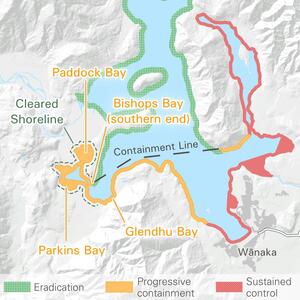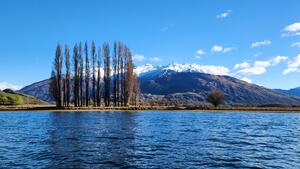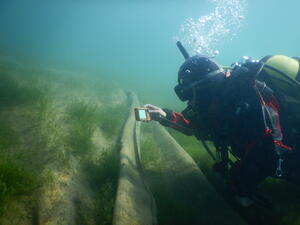Twenty years of dedicated effort and community support is finally paying off in the fight to clear Lake Wānaka of the invasive lakeweed lagorosiphon.
Lagarosiphon is one of New Zealand’s worst submerged weeds and it was first recorded in Lake Wānaka in the 1970s. It can form tall dense surface reaching weed beds that can interfere with recreational activities and smother out native plants.
Clearing Lake Wānaka of the invasive weed, lagarosiphon is the ultimate goal of agencies of the Lake Wānaka Lagarosiphon Management Committee led by Toitū Te Whenua Land Information New Zealand (LINZ).
This autumn, the management committee’s control programme is on track to remove weed beds remaining in the western part of the lake, which stretches over 13 kilometres of shoreline. This would allow the containment line to be moved further south to include the Paddock and Parkins Bays area, a long-awaited milestone.

A map of Lake Wānaka showing the containment line that separates the Eradication Zone in the north and the areas targeted for weed control in the south.
“The containment line represents the divide between cleared sections of the lake, which we continue to monitor, and where we need to actively fight lagarosiphon,” says LINZ Biosecurity Manager Tracey Burton.
“The containment line in Lake Wānaka currently stretches from the southern point of the peninsula to the southern point of Bishops Bay. The idea is to progressively push the line further down the lake towards Wānaka township and eventually eradicate lagarosiphon from the lake.
“Clearing Lake Wānaka is a priority for us, as it will help prevent the pest weed from spreading to other waterways in the region. If we can shut off the flow of weed entering through these pathways, we can move to clear downstream waterways too,” says Ms Burton.
NIWA Freshwater Ecologist Mary de Winton has been engaged by the management committee to independently inspect the weed control works in Lake Wānaka for over 10 years.
Over the past few years, Ms de Winton says she has seen “amazing progress” clearing weed beds and preventing reinvasion of cleared areas – particularly in Glendhu and Paddock Bays.
“It’s really exciting seeing native plants returning to the cleared areas and providing great habitat for other lake life,” she says.

This photo of Paddock Bay taken in 2005 shows dense weed beds of lagarosiphon reaching the surface. Image credit NIWA

Paddock Bay now has no surface reaching weed beds. This photo was taken in December 2023. Image credit LINZ
Ms de Winton says that the innovative use of hessian matting has been a gamechanger for eradicating lagarosiphon.
“Hessian matting was first trialed in New Zealand in 2016 at Lake Wānaka by LINZ’s biosecurity partner Boffa Miskell. The matting is biodegradable, so it disappears after it’s done the job of controlling the invasive lake weed. Best of all, native plant regrowth is fast because native seedlings can grow through the weave of the hessian.

A diver inspects hessian matting on the lakebed in Paddock Bay. Native plants can be seen growing through the matting. Image credit NIWA
“One super hard area to control was Paddock Bay. Lagarosiphon grew really fast here. Aquatic herbicide was used successfully to reduce the amount of weed. But it was hessian matting that finally smothered the weed beds. Now divers are removing the last scattered plants by hand.”
Jeff Donaldson from the Guardians of Lake Wānaka says the group is very supportive of the control programme led by LINZ.
“The development of hessian matting has allowed us to not just control the weed but eradicate it from areas throughout the western bays including Glendhu Bay - which is a very high use recreational area,” he says.
“Recreational activities like swimming and boating, in Paddock Bay have also been able to increase in recent years as the bay has been so much clearer of weed.”
Lagarosiphon was introduced to New Zealand as an aquarium plant, but it has spread rapidly throughout the country’s waterways. A fragment as small as a fingernail is enough to start an infestation.
Lagarosiphon can grow several metres tall, disrupting activities like swimming, fishing and boating and smothering native ecosystems.
“The Wānaka community and lake users are playing their part too - checking that their boats and other gear are free of plant fragments to prevent the weed from spreading” says Ms Burton.
“Boaties have also been asked to take care around areas where hessian has been laid to prevent damaging it.
“It is important lake users continue to Check Clean Dry to ensure pest species, like lagarosiphon and didymo don’t hitch a ride on their gear.”
Please remember to
Check your watercraft and gear for weeds, mud or pests and remove them at site or put them in the bin.
Clean your watercraft and gear with tap water, and then treat absorbent materials with hot water and detergent.
Dry your gear for at least 48 hours before moving to another waterway.
Check, Clean, Dry: preventing didymo and other pests | NZ Government (mpi.govt.nz)
Media contact
Email: media@linz.govt.nz